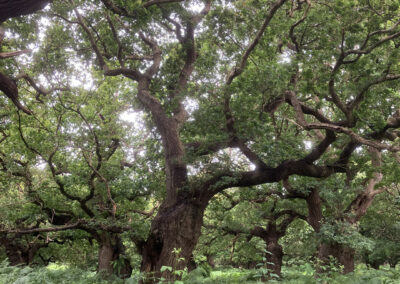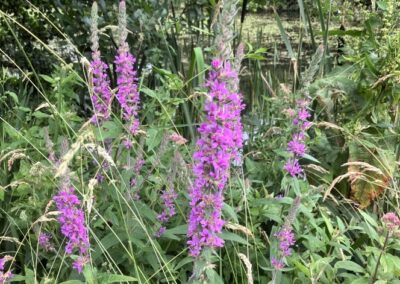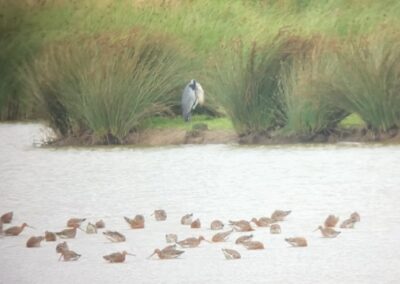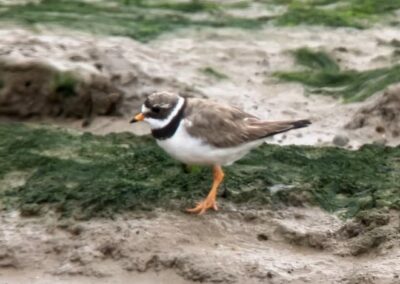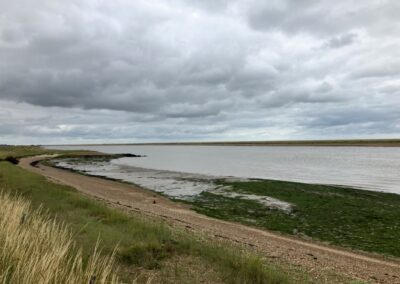Highlights
- Marvelling at the old oaks and hollies in Staverton Thicks…..
- ….whilst reading about the history of the Park
- A close Willow Emerald Damselfly at Wantisden ponds (pic above)
- Black-tailed Godwits and Spoonbill on the scrape at Hollesley
- Close Ringed Plover and distant Eider along the Ore
- A magnificent lunch back at The Froize
Seven group members including four making their Froize debuts met up with me for coffee at The Froize at 8.30am and I outlined our plans for the morning. We would spend the first part in Staverton Park and Thicks before moving on to Hollesley Marshes RSPB reserve to provide a real contrast.
Staverton Park is a 270 acre Site of Special Scientific Interest, with over 5200 trees including 4000 pollarded oaks, some over 400 years old, as well as some of the tallest holly trees in the country and some impressive birches. We walked along the public footpath which heads through ‘The Thicks’ and marvelled at the thick oak trunks and the shapes formed by the trees. It was all very green, but colour was provided by the bright rowan berries. Birds were in short supply given the grey conditions and the fact we were visiting in high summer when most species have finished breeding. Nevertheless we saw a Goldcrest and flocks of tits and heard Treecreeper, Great Spotted Woodpecker and Stock Dove.
Eventually we reached the northern section which is very different, comprising oaks which are much more spaced out; apparently the canopies cover about half of the ground area. The bracken under the trees was much higher than when I had visited in May. We strolled up the sandy track on the east side of the Park and soon reached the Shepherd’s Cottage which is famous as the subject of a book, The Cottage in the Forest by Hugh Farmar. It was lovely just to stand and reflect on the historic nature of the site we were visiting!
We noted that some oaks are being replanted at the northern end then headed a little further, to Wantisden ponds. The gloomy weather was frustrating as this spot is normally a haven for dragonflies, but we did manage to find a female Willow Emerald Damselfly and it allowed very close approach! This species is a relatively recent colonist in the UK and in fact I had seen my first ever here at Wantisden, in August 2009. Purple Loosestrife provided a splash of colour on the reed edge, and we noted Moorhens on the water and a Grey Heron overhead.
Eventually it was time to retrace our steps and pause once more in The Thicks where I read more Oliver Rackham quotes about this unique spot. Then we moved on for part two of our morning.
At Hollesley we took advantage of the facilities adjacent to the car park before strolling up the track, bypassing the viewing screen and making for the river wall. From this spot there was a wonderful panorama. To the north we could see Orford Castle, and panning clockwise we looked across the River Ore onto Orfordness before, to the south, looking towards Shingle Street to the south of the river mouth.
Turning round we scanned the man-made scrape with its islands for nesting birds. A large flock of Black-tailed Godwits caught our attention and we enjoyed watching them using their long beaks to feed in the deep water. We also spotted groups of young Shelducks and I explained this species uses a form of ‘creche’! Greylag and Canada Geese, Lapwing, Mallard, and Lesser Black-backed Gull were noted as supporting cast with Dunlin, Common and Green Sandpipers present but very distant even through the telescope. Having moved to a different vantage point we saw a Spoonbill, a strikingly large white bird and it conveniently woke up for a while allowing us to see its spoon-shaped bill. This species has recently started to nest on nearby Havergate Island.
A Skylark landed out of sight in the saltmarsh and beyond it a dark blob in the river proved to be an immature Eider duck, the first I had ever seen at this site. It shows you never know what you might find if you look. A Ringed Plover showed wonderfully well, a candidate for ‘Bird of the Day’.
As we pottered back we found three species of butterfly, Gatekeeper, Meadow Brown and Ringlet whilst a Reed Bunting sang monotonously and a Cetti’s Warbler called out of sight in the hedge.
Back at The Froize we had time to buy drinks from the bar before heading next door for a sumptuous feast! My personal choices included delicious duck and rabbit followed by a refreshing mango sorbet. Others tucked in to incredibly tasty vegetarian options.
We reflected on a splendidly varied morning at two very different sites then, before we went our separate ways, I flagged up the next Froize event – “The wonder of waders and other mudlarkers” – on Wednesday 14 August. Full details on the Froize website https://froize.co.uk/




